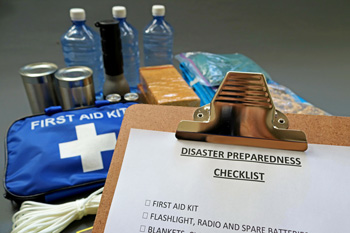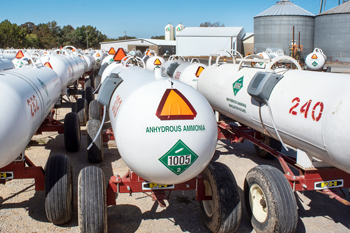Hazmat Preparedness
- Get Prepared
- Emergencies
- Current: Hazmat Preparedness
Hoosiers use and live around many hazardous chemicals and materials every day, whether they are household items or found at the workplace. These substances can have toxic effects and deserve special attention. Prepare now and follow the tips below so you know how to handle a hazardous substance incident in your area.
For a list of toxic substances and health effects, visit the Toxic Substances Portal on the Agency for Toxic Substances and Disease Registry website.
Hazmat Preparedness Tips
Quick Tips
- Build an emergency kit.
- Know how to turn off your home’s heating and cooling systems.
- Have multiple ways to receive guidance from local officials and public safety personnel.


Before an Incident (Prepare)
Make a plan: Think about and discuss what you and members of your household will do in case there is an incident. If toxic chemicals are released in your area, you may need to "shelter in place" or evacuate, depending on what local officials advise. Write down your plans using one of the forms on the Make a Plan page.
Build an emergency kit: The kit should include duct tape, scissors and thick plastic sheeting that can be used to seal windows, doors and vents to block potential contaminants from outside. Learn what else should be in your kit on the Disaster Kit page. Keep in mind you may have to shelter in place for an extended period of time and will need certain supplies on hand, or you may need to evacuate in a short period of time and will need important items ready to go.
Know your home: Be familiar with your home's heating and cooling (ventilation) system. Know how to turn off fans, air conditioning and forced air heating systems.
Know where to go: Locate a room in your home that is above ground and has as few openings as possible, to avoid as much potential exposure to chemicals from outside as you can.


During an Incident (Respond)
Listen for instructions: Local officials and public safety personnel will advise the public of actions you need to take. Depending on the type of chemical and risks of exposure, the guidance could be to stay inside or leave the area. Be sure to have multiple ways to receive this information: radio, television or a device with internet access.
Act quickly:
- Evacuate immediately if told to do so, and avoid going in the direction of the chemical if possible, whether the chemical is in a building you are in or nearby.
- If directed to stay indoors and shelter in place, go to an interior room, turn off and close all heating, cooling and ventilation systems and seal gaps where chemical gas or vapors can enter.
- When outdoors during an incident, find the fastest way to get to clean air and away from the incident (go upwind of the source, if known). Find a building to shelter in place. If inside a vehicle, turn off the heater and air conditioner, and keep the vents and windows closed.
- If you are being affected by chemicals, get help by calling the poison control center at 800-222-1222, calling 911 or going to the nearest hospital. If you cannot get medical help right away, decontaminate yourself:
- Remove all clothing and other items on your body. Avoid it contacting your eyes, nose and mouth. Put all contaminated clothing and items in plastic bags, then seal the bags. Remove contact lenses. Decontaminate glasses in household bleach, then rinse and dry them.
- Wash your hands with soap and water.
- Flush your eyes with water.
- Gently wash your face and hair with soap and water, then rinse thoroughly with water.


After an Incident (Recover)
Wait: Listen for instructions from local officials. Do not leave your shelter, go outside or return to the area until they say it is safe. Follow their guidance on decontamination procedures.
Seek medical help: If you were affected by chemicals and were not able to get medical help immediately, go to a medical facility to be treated by professionals.
Special Case


Anhydrous Ammonia Safety
Common Use
Anhydrous ammonia (dry or pure, undiluted ammonia) is frequently used by farmers for use as fertilizer. It is a colorless gas ordinarily but becomes a liquid when in pressurized tanks. This is the form that most farmers use it in when applying to their fields.
Dangers
Anhydrous ammonia takes water from anything it comes into contact with, including your body. It can damage the skin, lungs and eyes severely in only a matter of seconds. It causes painful burns and can cause suffocation, blindness and death.
How to Stay Safe
- "The Nose Knows": Ammonia has a distinct odor that irritates the nose, so you will smell it.
- Inspect hoses and valves, and make sure there are no loose connections. Replace old or damaged parts instead of repairing them.
- Follow instructions and do not overfill tanks, keeping in mind possible expansion. White paint helps keep tank temperature down, so keep the tanks painted white. Remove hazards that could heat tanks and cause dangerous pressure buildups.
- Wear protective clothing and equipment, such as a rubber suit or long-sleeved shirt and coveralls, gloves and non-vented goggles.
- First Aid: Have water on hand for immediate use in case of an accident. Immediate flushing of the eyes is critical to prevent permanent damage, so have a bottle of water with you and ready to use at a moment's notice. You may need to flush your eyes until you can reach the emergency water tank mounted on the farm vehicle.
Resources
Hazards Near Home: Local Emergency Planning Committees Keep You Safe
Each county has a Local Emergency Planning Committee (LEPC) that works with emergency managers, first responders and others to develop and practice emergency response plans and distribute information to the general public about hazardous substances nearby.
